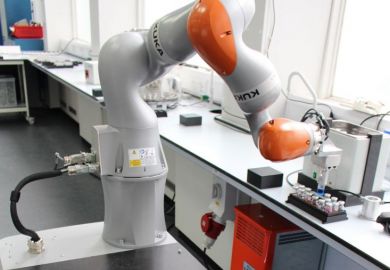Andy Meharg assays how chemistry has been used to kill, cure and colour
Distilled and extracted from the earth's crust by man is the poisonous array of elements that make up the periodic table. Every chemical element, in one or more of its forms, is poisonous.
From ancient times, humanity has been well aware of "nature's killing store", but toxicological concerns were put aside: arsenic, lead, mercury, selenium and antimony had a technological allure. They have strong antibiotic properties that made them valuable in treating disease, providing the dose did not kill. Metallurgy, pigments, food additives, tanning, glass-making and cosmetics also relied on this roster of elements. The wide technological use of toxic compounds led to mass poisonings. Evidence for this comes from the bones of the long dead. Analyses of Roman corpses show a high prevalence of lead poisoning. Elevation of arsenic and copper in ancient hair tissue is a sure sign of metal working. These metal and metalloid poisons leave their calling card. The Romans were famously poisoned by their lead plumbing and by a sweetening agent, sapa , made by boiling down unwanted wine in lead pans, which released saccharine lead acetate. The resulting syrup was used much as we use sugar today.
It is difficult to reconstruct what impact lead and elements had on the fitness of the ancients, but there is plenty of speculation. Lead poisoning results in developmental impairment - did the Romans' considerable lead consumption cause the collapse of their empire? Besides "accidental" poisoning, preparations of chemical elements were used for homicidal purposes, Nero's dispatch of Britannicus by arsenic being the most notorious example.
Far from learning the acquired Greek and Roman knowledge of the toxicity of the elements, the societies that followed - the great flowering of Islamic science, the Renaissance Enlightenment - persisted in poisoning themselves. The properties of toxic chemicals were simply too valuable. It was the rich who could afford metal-based medicines and metal-coloured pigments.
With the birth of modern chemistry and the Enlightenment, things got a lot worse. New chemical elements were found, novel chemical compounds were synthesised - most of which had very unpleasant side-effects to be balanced against their utility. Once the Industrial Revolution kicked in, the population of the Western world, rich and poor, was systematically poisoned. Arsenic, mercury and antimony were used routinely as medicines at dangerous doses. Rooms were decorated with killer pigments, arsenic greens and lead whites being the most dangerous. Puddings, cake decorations and sweets were coloured green with copper arsenite. Even purple socks, which had been dyed with an arsenical coal tar pigment, were known hazards.
Poisoning in the home was bad enough. But in the workplace, the indiscriminate use of toxins for a vast array of industrial processes had terrible consequences - spare a thought for the mad hatters who used mercury to create felt.
All in all, the 19th century was a poisoners' paradise - a host of cheap, deadly poisons was available with little or no regulation. The ubiquity of environmental poison in the home and in the workplace made it difficult to secure prosecution of suspected poisoners. To make matters worse, many metallic poisons induced symptoms that could be explained by natural disease; acute arsenic poisoning resembled cholera, for example. Early 19th-century advances in forensic science meant that trace amounts of chemicals could be detected in human tissues, food and drink, helping to incriminate deliberate poisoners. The great problem for the 19th-century courts was to try to distinguish between deliberate and accidental environmental poisoning.
Perhaps the greatest mystery is why it is only in the past 50 years or so that we have started to abandon the use of toxic metal salts in everyday items. Ignorance is often stated as the basis of our ancestors' liberal use of these dangerous chemicals. It is clear that they knew quite a bit about their toxicology - it was greed, necessity or laziness that often drove the commercial use of toxic salts. In doing so, they have left us a terrible legacy. Anyone living in an old unrefurbished house will have doors and windows painted in lead white or arsenic chromate. The soils in the gardens of our industrial cities are irrevocably polluted through years of atmospheric deposition from metal processing and refining. Leaded petrol made sure that no corner of the world was unpolluted by this element. Lead and arsenic were widely used as pesticides, poisoning agricultural land. Mercury spews from crematoria chimney stacks from the amalgam in our teeth. We live on soil polluted with the accumulated metal toxins of millennia.
John Emsley's book is a compendium of man's use and misuse of the periodic table. The text gives a brief summary of the environmental chemistry and toxicology of mercury, arsenic, lead, antimony and thallium before embarking on case histories of accidental and environmental poisonings involving these elements - some notorious, some not, but all interesting. He describes the chemistry with a light touch that makes the book accessible to non-chemists and, indeed, non-scientists. There is much here to fascinate a broad readership.
Andy Meharg is chair of biogeochemistry, Aberdeen University.
The Elements of Murder: A History of Poison
Author - John Emsley
Publisher - Oxford University Press
Pages - 404
Price - £18.99
ISBN - 0 19 280599 1


